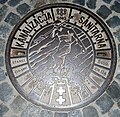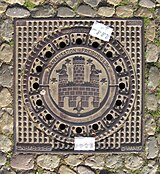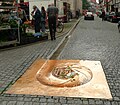Manhole cover

Manhole cover , also manhole cover (or colloquially channel grid , Gully lid , lock cover and in Switzerland and Swabia Dolendeckel of ahd. Dola chute tube) are predominantly of cast iron existing manhole covers for inspection and maintenance shafts of underground supply lines and sewers .
Smaller covers below the road surface installed fittings hot surface box , slide box , hydrant box , fire hydrant cap or lug .
General
The ancient Romans developed sewer grilles to protect passers-by, but also to stop objects that could fall or be thrown into them. These lids were almost always carved from stone.
Manhole covers can be opened and thus enable a descent into the inspection manhole or the sewer system. They can be backflow-proof, gas- and odor-tight and / or watertight. But there are also lids that have ventilation openings. However, these openings are very small so that larger objects cannot contaminate the channel. For this purpose a coarse sieve, the so-called dirt trap , is sometimes placed directly under the lid .
The EU standard for manhole covers is the European standard EN 124 from 1994. Outside Europe, it is also used worldwide on a voluntary basis. In Germany it is published as the DIN standard DIN EN 124.
material
Manhole covers made of cast iron ( gray cast iron ) are often decorated with the city arms. In Germany, manhole covers were often provided with a concrete- filled core during and after the Second World War in order to save metal. This type of construction ( BeGu , abbreviation for concrete casting) is still used today for reasons of cost. The more expensive all-metal version is used in Germany today for so-called roll-in manhole covers (see below) or often in representative locations, the cover is often decorated with a relief , usually the coat of arms of the city concerned. Concrete-filled lids are also used in Germany's neighboring countries, such as Poland , the Czech Republic and Austria .
Duct covers made of ductile iron were introduced in France . This enables lighter constructions with locking mechanisms and hinges and is also adopted in other countries.
Special trough-like manhole covers are usually made of hot-dip galvanized steel or stainless steel and allow the surface to be produced on site. They consist of a frame with a floor, which can be filled as required and can be paved.
Certain types are provided with a dampening neoprene insert inside the frame to reduce noise when driving over them.
Reasons for a round shape
The mystery of why manhole covers are usually made round, became known because it was used, among other things, in job interviews for Microsoft . The question allows several answers, from pragmatic ("manhole covers are round because manholes are round") to philosophical:
- A round manhole cover cannot fall through the circular manhole opening. This is possible if a square lid is inserted into the opening diagonally and at the same time upright. (A so-called Reuleaux triangle or a curve with constant width would also serve this purpose.)
- Round shafts have the advantage that the lateral earth pressure can be easily supported. Therefore, often in mine shafts (except wooden shaft lining ), wells , pipes of sewers and tunnels chosen this form. If the shaft is wider, a cone often leads to the cover. (→ Inspection shaft ) Telecommunication distributors that are not very deep and in which one needs more space, on the other hand, often have rectangular covers.
- tradition
- When an automobile rolls over the edge of an open round manhole opening, less damage may occur because the tire is gradually lifted out again along the inclined edge.
- Round manhole covers are easier to transport on wheels.
variants
According to EN 124 , a distinction is made between load classes A (accessible, 15 kN) to F (heavy load , 900 kN). Class D covers (up to 400 kN) with a nominal diameter (clear width of the opening) 600 or 800 mm are generally used on roads. The cover then, together with the rebate cover, typically has a diameter of 65 or 85 cm. The total visible diameter of an iron border is then at least 67 or 87 cm. Depending on the application, manhole covers contain inlet or ventilation openings, are surface water-tight or are screwed on.
Usually the frame rests on the shaft and is then embedded in the road surface. Self-leveling roll-in manhole covers made of ductile cast iron are also installed in asphalt roads , which do not lie directly on the manhole parts , but rather form a unit with the road surface.
Anti-theft devices and ventilation openings with a diameter of just 10 mm ( rat and mouse protection ) are also available. There is then no need for a dirt bucket below the lid.
Others
In countries where there is a lack of raw materials and where there is poverty, manhole covers are occasionally stolen, so that there are dangers for inattentive motorists , cyclists and pedestrians .
During major state visits, manhole covers are sometimes sealed or welded to prevent attacks.
Manhole cover in culture
In Hanover there is a manhole cover on the forecourt of the main train station , from which music can be heard. It is an installation by Reinhard Schamuhn realized by Michael Gehrke .
On the Bremen market square there is a replica of a manhole cover, which allows coins to be inserted through a central slot (" Bremer Loch "). When a coin is inserted, an animal sound typical of the Bremen Town Musicians is played.
In Hann. Münden , the water installation project water tracks was created for the EXPO 2000 world exhibition . This includes the bass plate as an oversized manhole cover made of bronze, into which the Beeke stream flows openly in a gutter .
The " Bremer Loch "
Sound gully of traces of water in Hann. Münden
See also
Web links
- Dolologie Association (Association for the Preservation of Protected Dolene Lids )
- Manhole covers (manhole covers from all over the world)
- Manhole cover (manhole cover mainly from Germany)
- China's gullies are disappearing at record speed. In: The world . November 24, 2004.
- Once again, the dome covers have been removed. In: Rümlanger Nachrichten . May 11, 2007.
- Map of Germany "Pictures on manhole covers" from ZEITmagazin, July 12, 2017.
Individual evidence
- ↑ Example of pavement covers .
- ^ Wilhelm Leo: Textbook of mining science . Printed and published by G Basse, Quedlinburg 1861.












